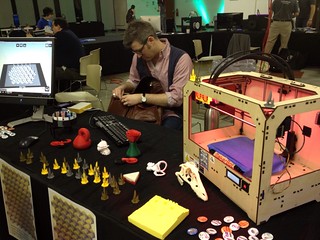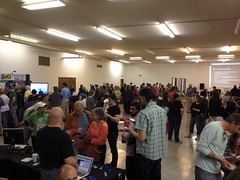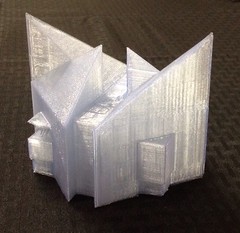On Feb 14, I got an intriguing email from Brian Matthews about a special edition of the Journal of Library Administration he was editing. It was a request for a chapter for an edition of the journal called Imagining the Future of Libraries, and the Brian’s pitch to me was enough to make me very interested:
[Brian]I’d love for you to contribute an essay around the topic of technology. Beyond most digital collections. Beyond everyone and everything mobile— what unfolds then?
I mean, if I have a specialty, this is it. I love nothing more than I love a good dose of futurism, and told him so. My one concern was the Journal’s publisher, Taylor & Francis, and the fact that I refuse to sign over my copyright on work I create. I’m happy to license it in any number of ways that gives the publisher the rights they need to distribute the work, but I won’t write something for someone else to own. From my reply email to him:
[Me]…there are definitely some details that I’d love to know before I commit. Just to check, this is the same Journal of Library Administration that’s published by Routledge/Talor & francis, correct? What is their author agreement like? I’m pretty dedicated to OA, and wouldn’t be willing to agree to any publication restrictions beyond something like a very short exclusivity clause.
Brian replied with a link he found to Taylor & Francis’ author agreement, which I read…and then responded, a bit more pointedly:
[me] I’ll be blunt: there is no situation in which I’d sign copyright over the T&F…or, frankly, anyone. I’m very happy to sign a license of limited exclusivity (say, 30-90 days) for publication, or license the work generally under a CC license and give T&F a specific exemption on NC so they can publish it. But their language about “Our belief is that the assignment of copyright in an article by the author to us or to the proprietor of a journal on whose behalf we publish remains the best course of action for proprietor and author alike, as assignment allows Taylor & Francis, without ambiguity, to assure the integrity of the Version of Scholarly Record, founded on rigorous and independent peer review. ” is just…well, bollocks.
I am very interested in the topic, and I’ve got a ton to say about it…would love to write it. But we’d have to work out the copyright issue.
Brian’s response from a week or so later indicated that the combination of speed of production (the deadline for the chapters was May 1) and the lack of communication from Taylor and Francis meant this wasn’t going to work out for me to be involved. I was bummed, but totally understood and let him know that I’d love to work on something else with him when the stakes were different.
Our conversation lasted just a couple of weeks, from Feb 14 to Mar 1. Imagine my surprise today when I saw a tweet from Meredith Farkas that said the editorial board of the Journal of Library Administration just resigned because of T&F practices.
Turns out that Brian himself seemingly broke the news in a blog post. From that post:
“A large and growing number of current and potential authors to JLA have pushed back on the licensing terms included in the Taylor & Francis author agreement. Several authors have refused to publish with the journal under the current licensing terms.”
“Authors find the author agreement unclear and too restrictive and have repeatedly requested some form of Creative Commons license in its place.”
“After much discussion, the only alternative presented by Taylor & Francis tied a less restrictive license to a $2995 per article fee to be paid by the author. As you know, this is not a viable licensing option for authors from the LIS community who are generally not conducting research under large grants.”
“Thus, the Board came to the conclusion that it is not possible to produce a quality journal under the current licensing terms offered by Taylor & Francis and chose to collectively resign.”
Between this, and Chris Bourg’s blog post about this event, it sounds like the editorial board had been working for some time to convince T&F of how much they needed to change their expectations for author licensing. Since their requests seemingly fell on deaf ears, they took the only step really offered them, and withdrew from their positions.
I applaud them this decision. I fully understand that I speak from a position of privilege, as I have the ability to turn down writing opportunities such as this without it effecting my career negatively, and that what I’m about to say is said from this same position, but: No scholar should be producing work, whether that work be the creation of content, editing of content, or other, for entities which insist that they are doing you a favor by taking away your rights or the rights of those you represent. I could not in good conscience write a piece that I would have very much enjoyed writing for a publisher that was intent on depriving me of my ownership of that selfsame work. And I am incredibly pleased that the editorial board came to that same conclusion, and that they could no longer support said deprivation.
Brian: if you would still like my participation in that collection, and you find another outlet for it that does respect author’s rights, I’m all ears. To the editorial board, and especially to Damon Jaggers: Bravo! Let us hope that all of you move on to journals that respect the makers of the work they rely on.



